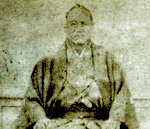Unryū Kyūkichi
Unryū Kyūkichi (Japanese: 雲龍 久吉, 1822 – June 15, 1890; name also read as Unryū Hisakichi) was a Japanese sumo wrestler from Yanagawa, Chikugo Province. He was the sport's 10th yokozuna.
| Unryū Kyūkichi | |
|---|---|
| 雲龍 久吉 | |
 Woodblock print of Unryū by Utagawa Kunisada II, 1864 | |
| Personal information | |
| Born | Shiozuka Kyūkichi 1822 Yanagawa, Chikugo, Japan |
| Died | June 15, 1890 (aged 68) |
| Height | 1.78 m (5 ft 10 in) |
| Weight | 135 kg (298 lb) |
| Career | |
| Stable | Oitekaze |
| Record | 127-32-55 15draws-5holds(Makuuchi) |
| Debut | November, 1847 |
| Highest rank | Yokozuna (September 1861) |
| Retired | February, 1865 |
| Championships | 7 (Makuuchi, unofficial) |
| * Up to date as of October 2007. | |
Career
He was born Shiozuka Kyūkichi (塩塚 久吉) in Yanagawa, Fukuoka, but would later changed his name to Satō Kitarō (佐藤 喜太郎). He lost his parents and grandmother in 1833.[1] He made his debut in Osaka sumo in May 1846. He moved to Edo in 1847. He was promoted to the top makuuchi division in February 1852.
Unryū was a strong wrestler at the beginning of his career. He had the equivalent of four consecutive championships upon entering the top makuuchi division (those this was before the championship system established in 1909). On the occasion of Matthew C. Perry's visit to Japan, he had an opportunity to display his wrestling prowess in a tournament Perry and his military advisors attended.[1] He was promoted to ōzeki in January 1858.
He was awarded a yokozuna licence in September 1861, but by that time he had already passed his peak and was unable to win a significant number of bouts after that. In the top makuuchi division, he won 127 bouts and lost 32 bouts, recording a winning percentage of 79.9.
Retirement from sumo

After his retirement in February 1865, he remained in the sumo world as an elder. He was the chairman (fudegashira) of Tokyo sumo in the early Meiji period, and he acquired a reputation for honesty.[2]
The name of one style of yokozuna dohyō-iri (ring entering ceremony) came from him. His ritual dance was said to be beautiful but it isn't proven that he performed the ritual dance in the Unryū style. His style is said to have been imitated by Tachiyama Mineemon,[3] but Tachiyama's style is called shiranui style now. This was due to sumo scholar Kozo Hikoyama, who without researching properly, labelled Tachiyama's style as being that of Shiranui Kōemon, whereas it was in fact created by Unryū. Hikoyama was such an authority that no one contradicted him, and the Shiranui name has stuck.[4]
Top division record
- The actual time the tournaments were held during the year in this period often varied.
| - | Spring | Winter | ||||
|---|---|---|---|---|---|---|
| 1852 | East Maegashira #7 8–0–1 1d Unofficial |
East Maegashira #3 7–1–1 1draw Unofficial |
||||
| 1853 | East Maegashira #2 6–0–2 1d 1h Unofficial |
East Maegashira #1 8–0–2 Unofficial |
||||
| 1854 | East Komusubi 3–3–1 3d |
East Komusubi 5–1–1 2d 1h |
||||
| 1855 | Called off due to fire | Not held | ||||
| 1856 | East Komusubi 4–1–4 1h |
East Sekiwake 9–0–1 Unofficial |
||||
| 1857 | East Sekiwake 7–1 |
East Sekiwake 7–1–1 1h Unofficial |
||||
| 1858 | East Ōzeki 5–2–3 |
Called off due to fire | ||||
| 1859 | East Ōzeki 5–2–3 |
East Ōzeki 3–1–4 1d 1h |
||||
| 1860 | East Ōzeki 5–2–1 2d |
East Ōzeki 5–1–1 |
||||
| 1861 | East Ōzeki 3–1–6 |
East Ōzeki 7–2–1 |
||||
| 1862 | East Ōzeki 6–2–2 |
East Ōzeki 6–1–2 1d Unofficial |
||||
| 1863 | East Ōzeki 4–3–3 |
East Ōzeki 5–1–1 2d |
||||
| 1864 | East Ōzeki 5–3–1 1d |
East Ōzeki 4–3–3 |
||||
| 1865 | East Ōzeki Retired 0–0–10 |
|||||
| Record given as win-loss-absent Top Division Champion Retired Lower Divisions Key: d=Draw(s) (引分); h=Hold(s) (預り); nr=no result recorded Yokozuna (not ranked as such on banzuke until 1890) Ōzeki — Sekiwake — Komusubi — Maegashira | ||||||
*Championships for the best record in a tournament were not recognized or awarded before the 1909 summer tournament and the above unofficial championships are historically conferred. For more information see yūshō.
See also
| Wikimedia Commons has media related to Unryū Kyūkichi. |
References
- 雲龍久吉…土俵入りに名残す横綱(福岡県柳川市) (in Japanese). Yomiuri Shimbun. Archived from the original on 2008-05-29. Retrieved 2008-07-04.
- 雲龍 久吉 (in Japanese). Retrieved 2008-07-04.
- "The 11th Yokozuna Shiranui Koemon". Sumo Fan Magazine. Retrieved 2007-10-10.
- Castella, Stehane; Perran, Thierry (February 2006). "History and evolution of the tsuna since 1789". Le Monde Du Sumo. Retrieved 2008-06-17.
- "Unryu Hisakichi Rikishi Information". Sumo Reference. Retrieved 2007-10-05.
External links
| Wikimedia Commons has media related to Unryū Kyūkichi. |
- (in Japanese) Unryu Hisakichi tournament result
| Preceded by Hidenoyama Raigorō |
10th Yokozuna 1861–1865 |
Succeeded by Shiranui Kōemon | ||
| Yokozuna is not a successive rank, and more than one wrestler can hold the title at once | ||||
